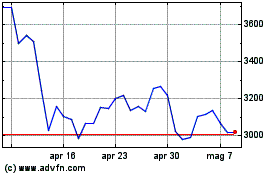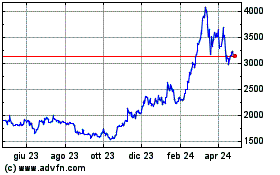Bitwise CIO Bullish On Ethereum ETFs Fueling Surge To Record Highs Above $5,000
18 Luglio 2024 - 2:30AM
NEWSBTC
As the highly anticipated launch date of spot Ethereum ETFs
approaches, Matt Hougan, Chief Investment Officer of crypto asset
manager Bitwise, has stressed the potential for these ETF inflows
to drive the Ethereum price to record highs. In a recent
client note, Hougan highlighted the significant impact that ETF
flows could have on the Ethereum price, surpassing even the effects
witnessed in the spot Bitcoin ETF market in the US. Ethereum
ETFs Poised To Surpass Bitcoin’s Impact? Hougan confidently
predicts that introducing spot Ethereum ETFs will lead to a surge
in ETH’s value, possibly reaching all-time highs above $5,000.
However, he cautions that the first few weeks after the ETF launch
could be volatile, as funds could flow out of the existing $11
billion Grayscale Ethereum Trust (ETHE) after it is converted to an
ETF. This could be similar to the case of the Grayscale
Bitcoin Trust (GBTC), which saw significant outflows of over $17
billion after the Bitcoin ETF market was approved in January, with
the first inflows recorded 5 months later on May 3. Still,
Hougan expects the market to stabilize in the long term, pushing
Ethereum to record prices by the end of the year after the initial
outflows subside, drawing a comparison with Bitcoin in key metrics
to understand this thesis. Related Reading: ‘Most Bullish Setup
Ever’: Crypto Analyst Lists 10 Reasons To Invest Now For example,
Bitcoin ETFs have purchased more than twice the amount of Bitcoin
compared to what miners have produced over the same period,
contributing to a 25% increase in Bitcoin’s price since the ETF
launch and a 110% increase since the market began pricing in the
launch in October 2023. That said, Hougan believes the impact
on Ethereum could be even more significant, and identifies three
structural reasons why Ethereum’s ETF inflows could have a greater
impact than Bitcoin’s. Lower Inflation, Staking Advantage, And
Scarcity The first reason Bitwise’s CIO highlights is Ethereum’s
lower short-term inflation rate. While Bitcoin’s inflation rate was
1.7% when Bitcoin ETFs launched, Ethereum’s inflation rate over the
past year has been 0%. The second reason lies in the
difference between Bitcoin miners and Ethereum stakers. Due to the
expenses associated with mining, Bitcoin miners generally sell much
of the Bitcoin they acquire to cover operational costs. In
contrast, Ethereum relies on a proof-of-stake (PoS) system, where
users stake ETH as collateral to process transactions accurately.
ETH stakers, not burdened with high direct costs, are not compelled
to sell the ETH they earn. Consequently, Hougan suggests that
Ethereum’s daily forced selling pressure is lower than that of
Bitcoin. Related Reading: XRP Whales Are On The Move Again – Here’s
What They’re Doing This Time The third reason stems from the fact
that a substantial portion of ETH is staked and, therefore,
unavailable for sale. Currently, 28% of all ETH is staked, while
13% is locked in smart contracts, effectively removing it from the
market. This results in approximately 40% of all ETH being
unavailable for immediate sale, creating a considerable scarcity
and ultimately favoring a potential increase in price for the
second largest cryptocurrency on the market, depending on the
outflows and inflows recorded. Hougan concluded: As I mentioned
above, I expect the new Ethereum ETPs to be a success, gathering
$15 billion in new assets over their first 18 months on the market…
If the ETPs are as successful as I expect—and given the dynamics
above—it’s hard to imagine ETH not challenging its old record. ETH
was trading at $3,460, up 1.5% in the past 24 hours and nearly 12%
in the past seven days. Featured image from DALL-E, chart from
TradingView.com
Grafico Azioni Ethereum (COIN:ETHUSD)
Storico
Da Giu 2024 a Lug 2024

Grafico Azioni Ethereum (COIN:ETHUSD)
Storico
Da Lug 2023 a Lug 2024
